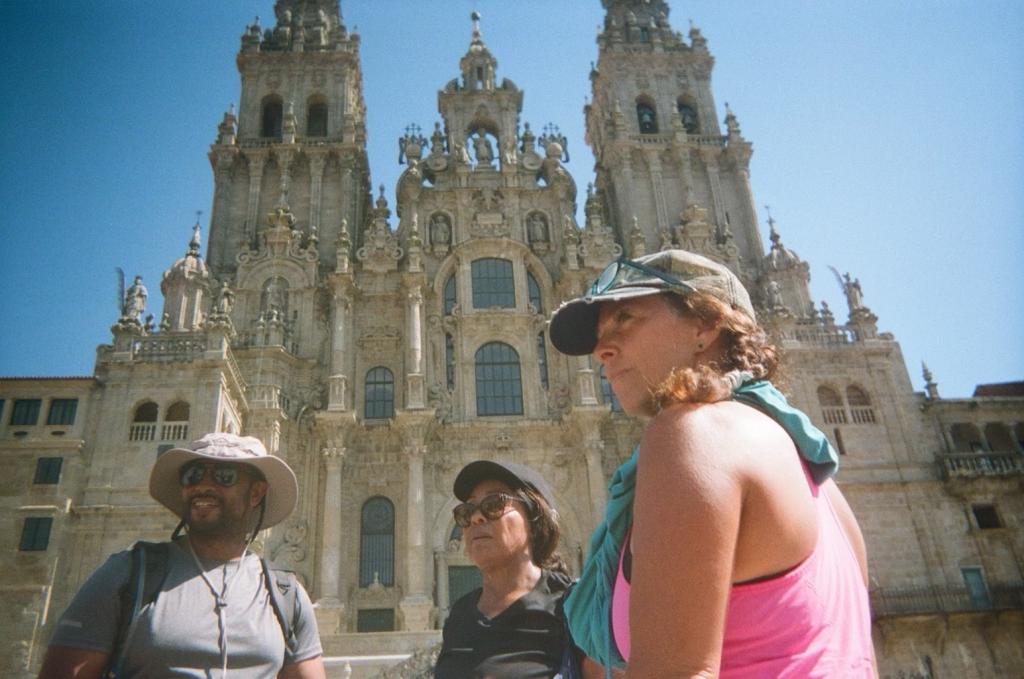
A pilgrim tends to take the side streets and back roads, resisting the temptation to hurry. They prefer to walk instead of relying on modes of transportation like Uber or the subway. This approach enables the traveler to observe, reflect, and fully experience their surroundings.
Like a connoisseur of wine, a pilgrimage must be savored and aged before its flavors come to life.
But even the first sip leaves an unforgettable taste, lingering on the palate long after the scenes have faded away.
As a pilgrim embarks on their journey, they are never truly alone. With each step, they are accompanied by the changing landscape and the ever-evolving cast of characters they meet along the Way.
Strangers become companions, sharing stories, proverbs, jokes, and pearls of wisdom that add depth and meaning to the journey. With each step, the pilgrim offers up a prayer and sheds the burdens of their past sins, finding renewal and rebirth with each passing mile.

At times, the road may be well-defined and easy to follow, but more often than not, it is full of rough terrain and steep inclines that attempt to discourage the pilgrim’s progress. If you embark on a journey with a superficial understanding of spirituality, you will soon realize that the mind, body, and soul are triune.
It is difficult to maintain the idea of dualism, which suggests that the spirit is trapped in the body when you are dealing with blisters, bleeding feet, and exhaustion after hiking up a mountain to reach a wooden cross.
As a pilgrim travels along the way, they will encounter moments where their faults, fears, and failures will emerge like bandits, lurking in the shadows, waiting to rob them of their most precious treasures.

The pilgrim clutches onto their walking staff and confronts the lies, trauma, and heartache that wish to derail their momentum. And through it all, the Good Shepherd will be there to guide them and provide them with the nourishment they need to keep moving forward.
While walking the Camino de Santiago, the pilgrim encounters numerous milestones that mark the progress of their journey. Crucifixes, statues of St. James the Apostle, and yellow arrows act as the northern star guiding the Pilgrim onward. Certain towns and forest trails have mounds of rocks with crucifixes at their center.

The act of adding a stone to the pile is a powerful experience that makes one more aware of the holistic depths of the journey they have embarked upon. Crossing countries on foot teaches the Pilgrim about embodied theology! As the pilgrim adds stone to the pile, they feel a sense of connection with all the other pilgrims who have walked this path before them.
In many ways, the ritual of adding stones to the pile is a metaphor for life itself. We impart a prayer or release a burden. It reminds us that we are all on a journey and that we each play a part in the sins and glory of our fellow man.
By adding our own stones to the pile, we contribute to something larger than ourselves – a collective human experience of overcoming obstacles, dying, and rising again.
The people the Pilgrim encounters radiate with the image of God. (Some of them may even be Angels.) It’s easier to look beyond the surface and see Christ in the faces of others. There’s a sense of kinship, that there truly is a mystical body of Christ. One is more a tune to the thread of life that holds all things together.
I remember telling Blake, a fellow Pilgrim that we could have had these open and honest talks while waiting for the bus to arrive. But in a city, a stranger remains a stranger. Our defense is up. Distractions and digital content occupy our attention. When the Pilgrim opens themselves up to encounter they can’t help but sing:
Christ is all, and is in all.















